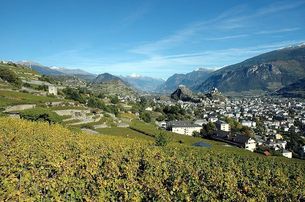Swiss wine

Vineyards in Sion
Swiss wine is produced from nearly 15 000 hectares of vineyards, and the wines are mainly produced in the west and in the south of Switzerland, in the cantons of Geneva, Neuchâtel, Ticino, Valais and Vaud. White grapes varieties are grown on 42% of the country's vineyard surface, and red grape varieties on 58%.
According to data from the Swiss Federal Office of Agriculture,[1] the Swiss wine production in 2009 was just over 1.1 million hectoliters, divided into 527 000 hl of white wine and 587 000 hl of red wine. Nearly all the national production is drunk within the national boundaries; less than 2% of the wine is exported (mainly to Germany).
According to data from the Swiss Federal Office of Agriculture,[1] the Swiss wine production in 2009 was just over 1.1 million hectoliters, divided into 527 000 hl of white wine and 587 000 hl of red wine. Nearly all the national production is drunk within the national boundaries; less than 2% of the wine is exported (mainly to Germany).
History
First grapes
The tradition of wine and viticulture in Switzerland is very old, at minimum from the Roman era. Some archaeological evidence seems to prove that the grapes were planted in Valais earlier than the Roman era. In an archaeological excavation near Gamsen, some old grape seed was found, and they date to the Iron Age. Also in Ticino some pollen was found in a palynology excavation. But this evidence does not really prove that the grapes were cultivated, as opposed to spontaneous grapes.
First wines
The first bottle, made in ceramic, was found near Sembrancher (Valais), in a Celtic tomb of a lady of 2nd century BC. These bottles are named vases a trottola, and they are produced in some Celtic farms in northern Italy. From an inscription on the bottle, we know that it contained wine. Around the 150s BC, in the Celtic era, the people in Valais offered wine to the dead, and probably they also drank the same wine. After a century, the Roman amphorae also appeared.
References
Extracted from:http://en.wikipedia.org/wiki/Swiss_wine
The tradition of wine and viticulture in Switzerland is very old, at minimum from the Roman era. Some archaeological evidence seems to prove that the grapes were planted in Valais earlier than the Roman era. In an archaeological excavation near Gamsen, some old grape seed was found, and they date to the Iron Age. Also in Ticino some pollen was found in a palynology excavation. But this evidence does not really prove that the grapes were cultivated, as opposed to spontaneous grapes.
First wines
The first bottle, made in ceramic, was found near Sembrancher (Valais), in a Celtic tomb of a lady of 2nd century BC. These bottles are named vases a trottola, and they are produced in some Celtic farms in northern Italy. From an inscription on the bottle, we know that it contained wine. Around the 150s BC, in the Celtic era, the people in Valais offered wine to the dead, and probably they also drank the same wine. After a century, the Roman amphorae also appeared.
References
Extracted from:http://en.wikipedia.org/wiki/Swiss_wine
